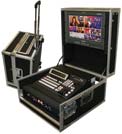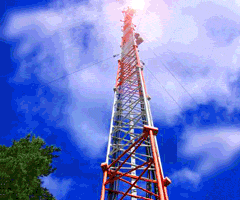|
|
Engineering travel is always fun...well, maybe not so much.
It's not the travel so much as the associated issues. Seldom does an engineer or tech travel without some sort of equipment. That creates two problems:
Protecting expensive equipment in shipment
Explaining an Operating Impedance Bridge or Network Analyzer to security officials
That said, here are some travel suggestions for techs.
Travel in the US:
- If you're taking gear, do your best to carry it on. Yes, check your clothes but carry on the gear. It won't get tossed around by baggage handlers. With some small planes, you carry on an item only to find that when you get to the gate, they want you to gate check it. That's the worst of all worlds. If you have a bag that won't fit and it's housing your OIB, take the OIB out of the bag and carry it on by itself, storing it overhead. Wrap it with bubble wrap if you want to protect it but carry it on. Of course, the bubble wrap leads to...
- ...strange looks and lots of questions from security. Be ready to answer - although carrying the manual with you will help. (We're NOT recommending that you go into a lengthy explanation of how the device works, boring them till they finally wave you on. However, that has worked in the past.)
- Be ready to explain how residual explosive chemicals might be on your gear. Don't think you'll ever experience that? If you use an FIM anywhere near farms, fertilizers can be blown across the instrument and they'll give an indication on the ionizer.
- Be sure you have a business card handy in case they ask "what you do."
- Whatever it is, watch it go into the x-ray. Don't go through the metal detector/backscatter scanner until you see the gear go through the curtain. Then, keep an eye on the other side to make sure you see it when it comes out.
- If the gear won't fit as carryon, and you have to ship it, consider the following: Ship it in advance - FedEx, DHL, whatever. Have them pack it then insure it fully...and ship it well in advance of your arrival so that it doesn't get lost while you're in the air!
- In all cases, take any batteries out and remove connectors, leads and other removeables, storing them separately. Definitely remove power supplies if the device transmits or has a local oscillator. (10.7 mHz higher than a lot of the FM band is right in the air navigation/ATC band.)
- If you're determined to check it, get flypacks - good flypacks. Anchor everything properly and protect all protrusions. Nothing like a BNC that's sheared off in transit to ruin your arrival.
- When you retrieve a checked bag, first, do not remove the bag check. While it's still attached to the bag, it's proof that you're holding the bag that you actually checked. Then, open it front of a baggage agent. Not a handler or skycap, one of the airline's baggage agents. You can point out any damage as you open it together.
- If, as you open a checked bag, you see a TSA notice that the bag has been opened for inspection, you will face any number of complications in rectifying any damages. First, the airline will deny coverage saying that it was repacked improperly. Second, TSA will require a form and report which after a lengthy wait will more than likely result in a claim denial. Their advice in that denial is that if wish to pursue the claim you must do so through the court system.
- Make sure your identification is all over the boxes - and not just hang-tags. Use self-adhesive labels in addition. Then, if you can, put a business card in the battery compartment or slide it inside the box where no one will find it until you tell them it's there.
- While you're at it, put "THIS SIDE UP" if there is an "UP." If they open a tool kit upside down they'll throw things back in any way they can.
- Whether you ship or check it, put a copy of the itinerary both inside and outside each box.
- Make sure it gets stolen by putting "Expensive Electronic Equipment - Do Not Drop" on all sides. Don't do it. Besides, it sometimes gives baggage handlers the challenge to hoist it an extra foot before throwing it on the loading belt.
Some general suggestions:
- Prepaid room? Take your receipt and when you get to the hotel, ask for a printout of their record of the prepayment. Sometimes you find a discrepancy that's a lot easier to resolve on checkin than on checkout.
- Rental car? Give it the pilot's walkaround and make note of scratches.
- Give family, co-workers, friends a code word telling them that, unless they hear the word, they should not send money or call area codes like 809
- If you buy things while out of town, don't carry them in bags with expensive logos. Put your lunch in a Neiman Marcus bag and it may well get stolen
- When you land, check the gear as soon as you can, before you leave the airport, if possible.
Special International Travel Suggestions:
- See if you can get translation of what your gear does into the language of the country you're traveling to. It may help you get it through security on the way home.
- If the gear's pretty worn, no big deal, but if it's new, you may want to bring proof of US purchase to get it through customs. Especially true if you're going to the country where the gear was manufactured. US customs has a record of serial numbers for a wide variety of devices - those imported into the US and otherwise. In other countries, that's not necessarily the case. And, in the US, don't count on customs having records on the latest Rhode & Schwartz gear you're bringing back from Germany.
- Buy a phone card in the US for calling the country you're traveling to. Give the number and password to clients along with your number at the hotel
- Double check your cell provider's policies for international calls and data. Many of them have hefty surcharges on both, especially data. $10 an SMS message can add up. Put Skype on your computer.
- Take every adapter known to man that you may need. It's doubtful that you'll find them where you're going. Murphy says so. Also, take spare batteries.
- Take a spare computer power supply!
- Have patience with LIP's who probably aren't accustomed to standing "in line" or "on line." They can make you feel like you want to be Jordan coming down with a rebound, swinging your elbows just to keep your place.
Richard Rudman, rar01@oldradio.com was kind enough to send along some great, and really helpful thoughts:
- U.S. Customs and Border Protection (CBP) has a form that is supposed to be signed by them when you leave the country with equipment that has serial numbers to ease your entry back into the country. While I have brought equipment back in the country without it, it makes life a lot easier when you are directed by the CBP officer to "follow the red tape on the floor" to the special inspection section when they see you pushing a cart with field cases on it. The Customs form is a 4455 and is called a "Certification of Registration". Instructions are on the form. Half the time the inspectors do not even open the field case when the form is signed by them and, on re-entry, they just check in the form through their computer system and do not open everything.
- If you do a lot of international travel, it is definitely worth signing up for the CPB "Global Entry" program. Global Entry is a CBP program that allows expedited clearance for pre-approved, low-risk travelers upon arrival in the United States. It involves a $100 fee for a five year period, filling out a form to tell them who you are, and a personal appearance at a CPB office for an in-person interview and photo. But once signed up, you can scan your passport at a kiosk at many U.S. ports of entry, go directly to a special "Global Entry" line to get through Customs, thereby avoiding the long line for those not aware of the program. Doesn't spare you from "following the red tape", but I have found that it sure speeds up the process.
- For domestic travel, if you are registered the Global Entry program, you can qualify as a "Trusted Traveler" and go through a special TSA line at a growing number of domestic airports where you might even not have to take your shoes off.
Just a few thoughts to make your trip easier. If you want to add anything, send a note to info@scopefocus.com
|
Scope+Focus, Inc.
Your contact for:
CAP and EAS upgrades, installations & management
Broadcast Field Service - AM, FM, TV...Contract and Emergency
Analog and Digital Studio-Transmitter Links
FCC Applications
Directional AM Measurements
Remote Broadcast and Remote Pickup Licensing
Studio Design and Construction
Field Strength, Field Intensity Measurements
Antenna Proofs
Translator Application and Cnstruction
Site Moves
|
|





